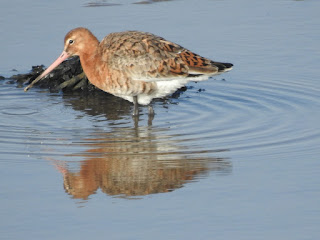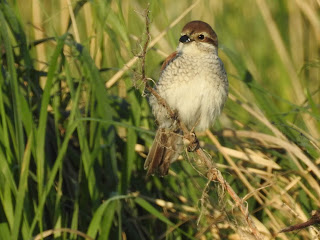It didn't take me long to drive there, with the roads quiet. I parked in my usual place and headed off along the path, after about 200 metres, I recalled that I had a spare pair of "Original Lithuania" gloves that I purchased at Kaunas Airport after wanting to rid myself of the old currency before Lithuania moved to the Euro. They were in the most obvious place, in the glove compartment in my car. I nipped back to the car, I had a sense of deja vu except with warm hands.
 |
| Reed Bunting |
The first bird of note was a singing Chiffchaff, I changed my direction to try and seek it out. I spotted it straight away, but no chance of a photograph as it was moving constantly. I walked up alongside the golf course, flushing some Red-legged Partridge and startled an early morning jogger, I stopped to observe the 2 metre social distancing. Other birds in the dunes were Meadow Pipits parachuting, Skylarks ascending and Reed Buntings singing.
 |
| Black-tailed Godwit |
I walked up to the coastline and there were was a mesmerizing cluster of Knot, Black-tailed and Bar-tailed Godwits, Curlew, Oystercatchers and Redshank. Also Turnstone, Ringed Plover and Dunlin. My main target was Wheatears, which are often standing tall on the rubble. There was no sign. I carried on towards the Hightown end and a number of Shelduck and Cormorants were hanging out along the end of the River Alt. The usual Gulls were vocal; Black-headed, Common, Herring, Lesser Black-backed and the graceful Great Black-backed.
 |
| Stonechat |
I thought I'd try the other end and head towards Crosby, so I turned around and then a male Wheatear appeared on a small bush. I didn't have my camera handy and it dropped down onto the rubble, out of sight. I carried on and then spotted another, assuming it wasn't the same one, but this time it flew inland into the dunes out of sight. I carried on but no further sightings. I headed inland and walked along the golf course fence. Plenty of Linnets singing on the top of bushes and the odd Stonechat. There wasn't too much in the way migration, just one or two Pied wagtails. No (hoped for) Swallow, Sand Martin or Ring Ouzel.
 |
| Cluster of Knot |
I then headed down the path towards the railway, but just some common birds, with more Chiffchaff and a Great Spotted Woodpecker the only birds of note. I thought I'd give myself another half hour and headed to the bench on the front, for a sit-down and drink from my oft used flask, with more dents in the cup than a dodgem at Southport Fair. Luckily the bench was free and noticed an increase in the number of Knot, flying in the closely-knit groups.
There was a noticeable increase in the number of cyclists, runners, walkers and dog walkers along the path and decided I'd head back to my car, knowing it might be my last visit here before the lockdown is lifted. I saw 47 species, but just the one tick for my 2020 Patchwork Challenge.
























